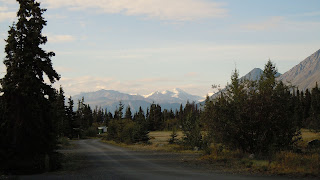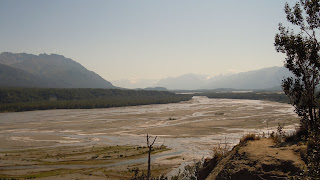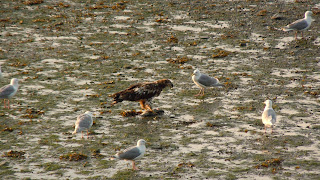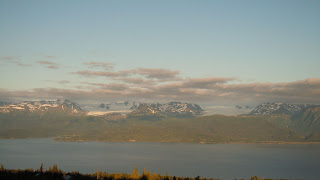We left Tok on Friday, headed for Destruction Bay, Yukon
Territory about 225 miles away. The border crossing went smoothly, but we can’t
say the same for the Alaskan Highway. At
first the road was fairly smooth, but then we ran into from many frost heaves. Frost
heaves are the result of the permafrost melting below the road causing the road
surface to literally drop. It’s very hard on the RV suspension, unless you really
slow down and we did. The Alaskan Highway between Tok and Destruction Bay has
always been notorious for frost heaves.
Then we ran into miles and miles of road construction. Sections
of the road construction projects (to fix the frost heaves) were gravel, but the
surface had serious washboard and it shook the RV and contents really bad, even
when we slowed down to 15-20 mph.
In early-July I included a photo of fireweed, with its
beautiful magenta color. We have seen colorful fireweed all across Alaska the
past month. The flower petals were only half-way up the stem in early-July, but
now they are nearly to the top, which is supposed to indicate the end of summer
or only six weeks until winter in Alaska.
We overnighted Friday night at Congdon Creek Campground,
a Yukon Territory government campground on the shores of Kluane Lake. The lake is
big, wide and about 50 miles long, and surrounded by mountains. The campground
is known to have bears and Vince & Lisa saw a grizzly on the shoreline
before we got there. The campground provides free firewood and we enjoyed a nice
campfire before dinner. Vince pan fried the halibut cheeks we had from our halibut
catch and they were amazing.
Saturday morning we drove about 60 miles to Haines
Junction, refueled the motorhome, then headed down the Haines Highway, about another
150 miles to Haines. We had reservations at the Oceanview RV Park, next to the
boat harbor, right on the Lynn Canal. There is only one row of back-in campsites
and we have a great view of cruise ships passing on their way to/from Skagway. There
are several resident bald eagles and bears nearby.
We volunteered to help Joyce, the RV park owner, with her
twice-a-week crab feed. It’s a potluck where you pay $10 for a Dungeness crab
and bring a side dish. About 3PM we went with Joyce to the boat harbor next
door where we got 30 crabs from a local fisherman, fresh right off the boat.
Then we helped kill and clean the crabs at the dock. We took them back to the
RV park and iced them down. We later steamed the crab for the 6PM dinner.
We’ll be here for a week, the longest we’ve stayed
anywhere on our trip. Monday we have tickets to take a Alaska Fjordlines boat day
trip to Juneau. The boat stops along the way to watch whales and other sealife.
We’ll have about 3 ½ hours in Juneau for lunch and sightseeing and also stop by
the Mendenhall Glacier on the way back.
Steve & Julie Cornelius


































































